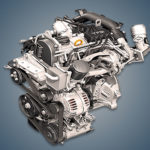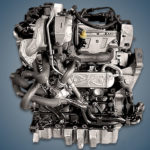The 1.6-liter Volkswagen CWVA 1.6 MPI gasoline engine was introduced in 2014 as the most simple and inexpensive engine for developing countries. This power unit was developed on the basis of a 1.4-liter turbo engine of the EA211 family and therefore has many differences from its predecessor CFNA, which belonged to the old EA111 series.
Here the cylinder head is combined with an exhaust manifold, a timing belt instead of a chain, and there is also a phase regulator on the intake shaft. Power increased from 105 to 110 hp.
The block is cast from aluminum with cast iron sleeves, cylinder head – 16-valve with hydraulic compensators. The connecting rod and piston group has undergone a serious modernization, there are no problems with knocks. Thanks to the new exhaust design, the engine’s environmental class was raised to EURO 5.
The EA211 series includes: CWVA, CWVB, CJZA, CJZB, CHPA, CMBA, CXSA, CZCA, CZDA, CZEA, DJKA, DACA, DADA.
Specifications
| Production years | since 2014 |
| Displacement, cc | 1598 |
| Fuel system | injector |
| Power output, hp | 110 |
| Torque output, Nm | 155 |
| Cylinder block | aluminum R4 |
| Block head | aluminum 16v |
| Cylinder bore, mm | 76.5 |
| Piston stroke, mm | 86.9 |
| Compression ratio | 10.5 |
| Features | DOHC |
| Hydraulic lifters | yes |
| Timing drive | belt |
| Phase regulator | on the intake shaft |
| Turbocharging | no |
| Recommended engine oil | 5W-30, 5W-40 |
| Engine oil capacity, liter | 3.6 |
| Fuel type | petrol |
| Euro standards | EURO 5 |
| Fuel consumption, L/100 km (for VW Polo Sedan 2016) — city — highway — combined |
7.8 4.6 5.8 |
| Engine lifespan, km | ~220 000 |
The engine was installed on:
- Skoda Karoq 1 (NU) since 2019;
- Skoda Octavia 3 (5E) in 2014 – 2020; Octavia 4 (NX) since 2020;
- Skoda Rapid 1 (NH) in 2015 – 2020; Rapid 2 (NK) since 2019;
- Skoda Yeti 1 (5L) in 2014 – 2018;
- Volkswagen Caddy 4 (SA) in 2015 – 2020; Caddy 5 (SB) since 2020;
- Volkswagen Golf 7 (5G) in 2014 – 2017;
- Volkswagen Jetta 6 (1B) in 2016 – 2019; Jetta 7 (BU) since 2020;
- Volkswagen Polo Sedan 1 (6C) in 2015 – 2020; Polo Liftback 1 (CK) since 2020;
- Volkswagen Taos 1 (CP) since 2021.
Disadvantages of the VW CWVA engine
- The most famous problem is high oil consumption and it increases due to the occurrence of rings. The owners are struggling with the oil burner by selecting the optimal lubricant and not without success. It is worth remembering that there is no oil level sensor and you have to regularly get the dipstick.
- Due to the design of the exhaust system of this engine, exhaust gases constantly break back into the cylinders, which causes thermal imbalance. This leads to uneven operation of the motor, vibrations, and also reduces its resource. Since the exhaust here is made together with the cylinder head, it will not be possible to replace it with an alternative one.
- If you find fresh traces of grease in the timing belt housing, then the camshaft seals are most likely leaking. However, the operation to replace them is quite inexpensive.
- A plastic water pump with two built-in thermostats often starts leaking at 100,000 km. The problem is not the fact of a leak, but the impressive price of the part.
- As soon as the oil approaches the minimum mark, hydraulic lifters begin to knock under the hood. They are especially audible in the cold, when the unit has not yet warmed up.






